
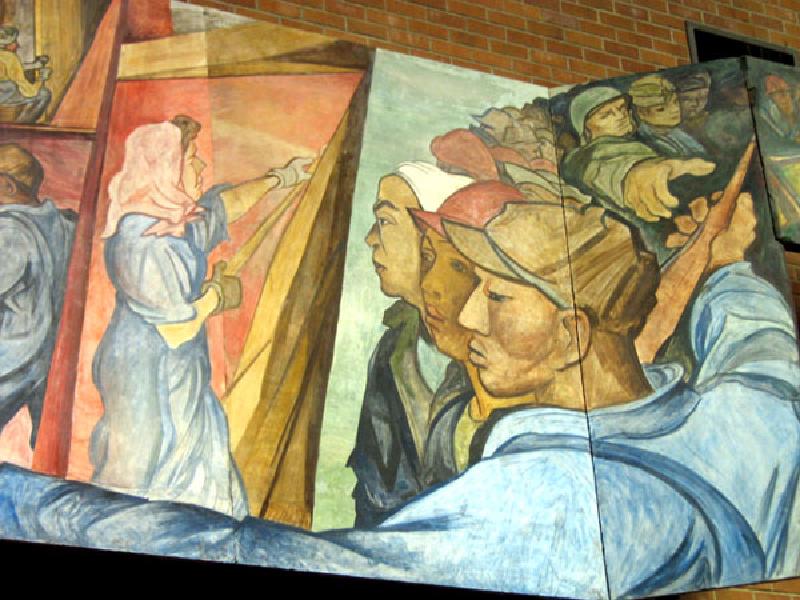
On the UW campus, a hidden treasure hangs in plain sight, on the second floor of Kane Hall. A fresco, “The Struggle Against Racial Discrimination” is one of only two murals painted in the United States by Pablo O’Higgins, a renowned figure in Mexican artist circles in his time. In 1945, Local 541 of the Ship Scalers Union (SSU) commissioned him to paint this work for their Seattle hall, the site of local leftist events as well as their union activities.
The Ship Scalers cleaned ships in the important Pacific Rim port of Seattle and when they commissioned the mural, they comprised an interracial union active in civil rights. Like Pablo O’Higgins, they participated in cross-border flows of art, labor activism, and politics that connected the US West Coast to Mexico and the Pacific Rim. Over a decade after the fresco was painted, the Ship Scalers moved to a new hall and donated the artwork to the University of Washington. The mural “disappeared” for almost a generation, and in the 1970s, student and community activism led to its recovery. This lobbying was part of new “struggles against discrimination” that were also shaped by Mexican influences.
This mural, powerful in its own right, has an intriguing history that is significant in three major ways. First, the journey of the mural illustrates the dynamics between Seattle and Mexico, between local developments and transnational currents. Second, activists were responsible for the creation of the mural and its journey to Kane Hall. Finally, though archives have helped to reconstruct and even correct the known history, there are still some mysteries about the mural’s journey, reminding us that scholarship is always unfinished business.
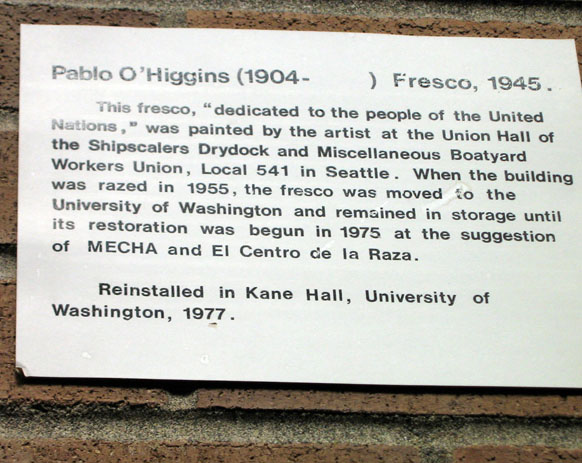 Original plaque, second floor Kane Hall. Photo: Oscar Rosales Castañeda.
Original plaque, second floor Kane Hall. Photo: Oscar Rosales Castañeda.
For many years, a plaque hung next to the mural and—like many other historical markers—presented a misleading view of the past to the public. In 2016 it was updated to note that the artist had died in 1983. This revised plaque still stated that the mural moved from its original site in 1955, when the union hall was “razed.” The year was inaccurate, based on a slip of memory that became reinforced in telling and in print for many decades. The hall was not razed in 1955; the union sold it in 1959. Finally, the plaque used the term “suggestion” to describe the influence of a student organization, MECHA, and a community organization. That obscured the conflict that was key to the recovery of the mural. Thirty years after the mural was painted, “The Struggle Against Racial Discrimination” was an ongoing struggle. It still is.
A quick tour of the mural
The mural situates the Ship Scalers in a global context of defeating fascism and other forces of oppression. O’Higgins used some of the members of Local 541 as models and incorporated internationalist images, including the likeness of a key Mexican labor leader of the era who promoted collaboration between Mexican and US labor and civil rights activists.
Originally, the sixty-foot long mural wrapped around the interior of the union hall, as seen in the photo of this meeting of the Washington Pension Union. Illustrating its members’ integration into activist networks, the Ship Scalers’ union hall served as a meeting place for many community organizations and events.
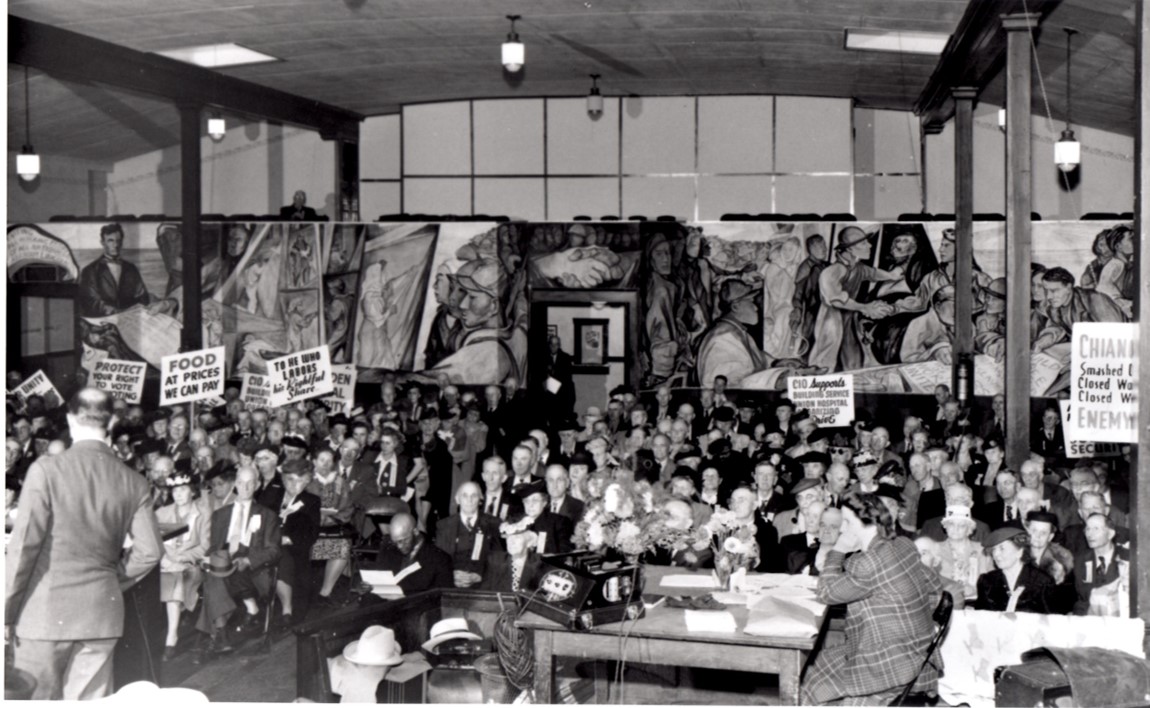 Washington Pension Union meeting at Ship Scalers Hall, n.d. Accession 185: Washington Pension Unions records, University of Washington Libraries Special Collections.
Washington Pension Union meeting at Ship Scalers Hall, n.d. Accession 185: Washington Pension Unions records, University of Washington Libraries Special Collections.
The mural is distinctive in shape as well as composition. Conforming to the walls and doors at the union headquarters, panels undulate, joining near the center at angles instead of lying flat. Adding to the dramatic geometry is the center panel of clasped hands that originally bridged the top of a doorway. These shapes are even more arresting now that the whole work hangs suspended nearly 20 feet from the floor in the popular UW lecture hall. Unfortunately the placement makes it hard to view and hundreds of students daily pass underneath without noticing. The floor area in front of the mural is narrow and one cannot step back far enough to see it in its entirety. Nor can it be captured straight on in a single camera shot.
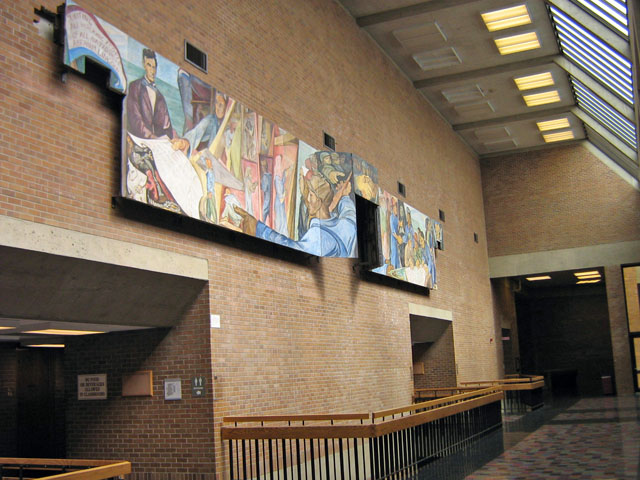 The mural hanging in Kane Hall. Photo: Oscar Rosales Castañeda.
The mural hanging in Kane Hall. Photo: Oscar Rosales Castañeda.
In the style and content of this fresco, we see not only the hand and vision of the artist but his training as part of the Mexican muralist movement of the 1920s-40s, which incorporated historical references to make political statements. This is the milieu in which O’Higgins developed as a visual artist. He also was a member of the Mexican and U.S. Communist parties, and in the early 1940s the latter proclaimed communism as “twentieth century Americanism.” On the left side of the fresco are some familiar images with mainstream appeal, progressing to more radical iconography on the right-hand side, with workers themselves in control.
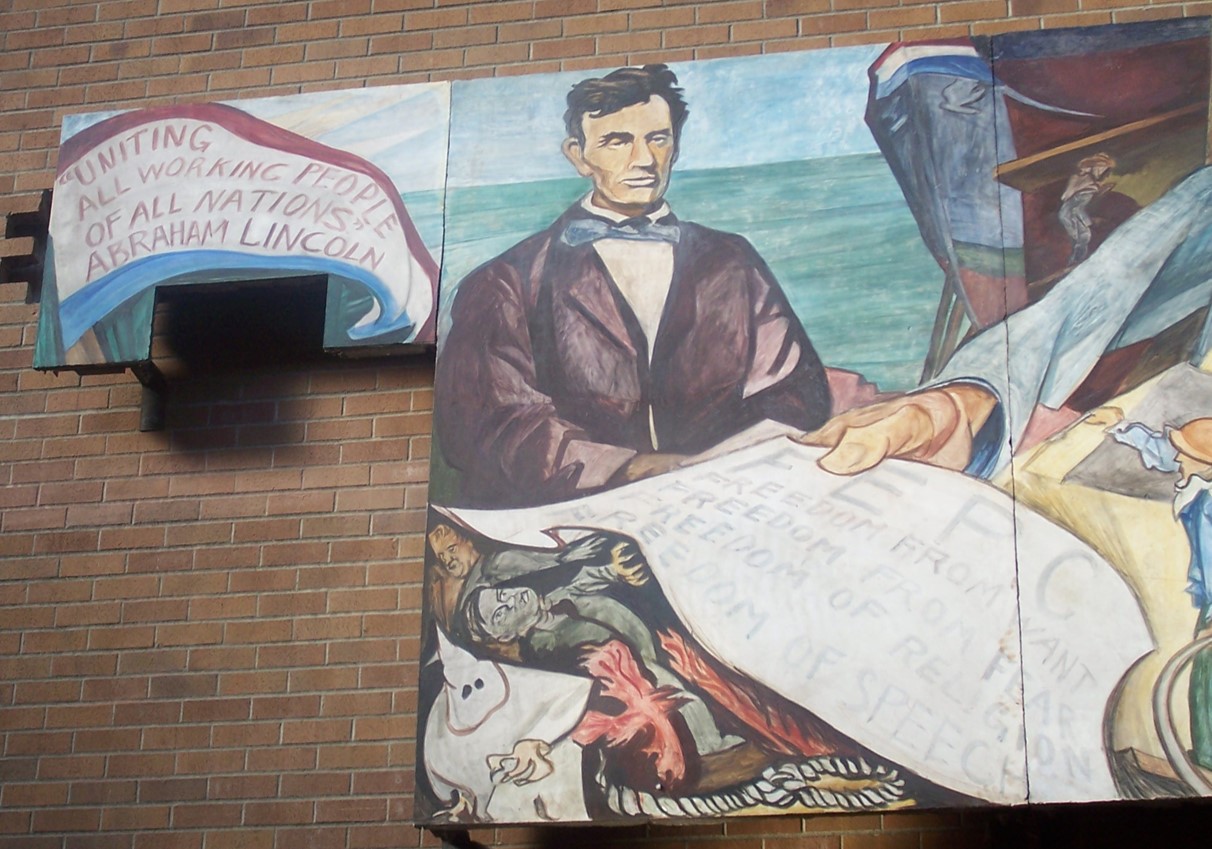 Mural 1: Lincoln. Photo: G. M. Peterson.
Mural 1: Lincoln. Photo: G. M. Peterson.
The leftmost panel of the mural is a small one, with part of an 1864 quote by Abraham Lincoln identified only by its proximity to his portrait. It reads “Uniting all working people of all nations.”1 Lincoln stands with a ship’s hull behind his left shoulder; the waterfront workers are part of history.
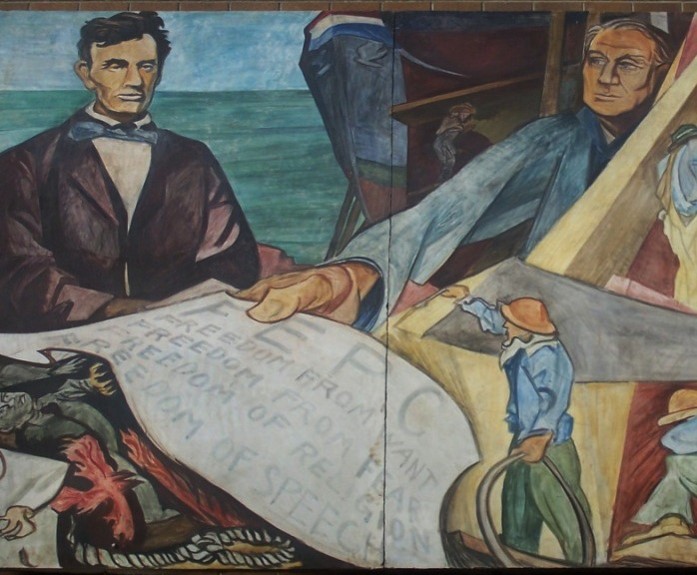 Mural 2: FDR. Photo: G. M. Peterson.
Mural 2: FDR. Photo: G. M. Peterson.
An even larger figure of Franklin Delano Roosevelt holds out a paper with the heading “FEPC” and “Four Freedoms” listed below. The document appears to crush agents of oppression at bottom left: a hooded Ku Klux Klan figure, greyish villains, and a noose. The Ship Scalers supported the “FEPC”—the wartime Fair Employment Practices Commission tasked with investigating workplace discrimination—and sought to have it conduct hearings in the area.2
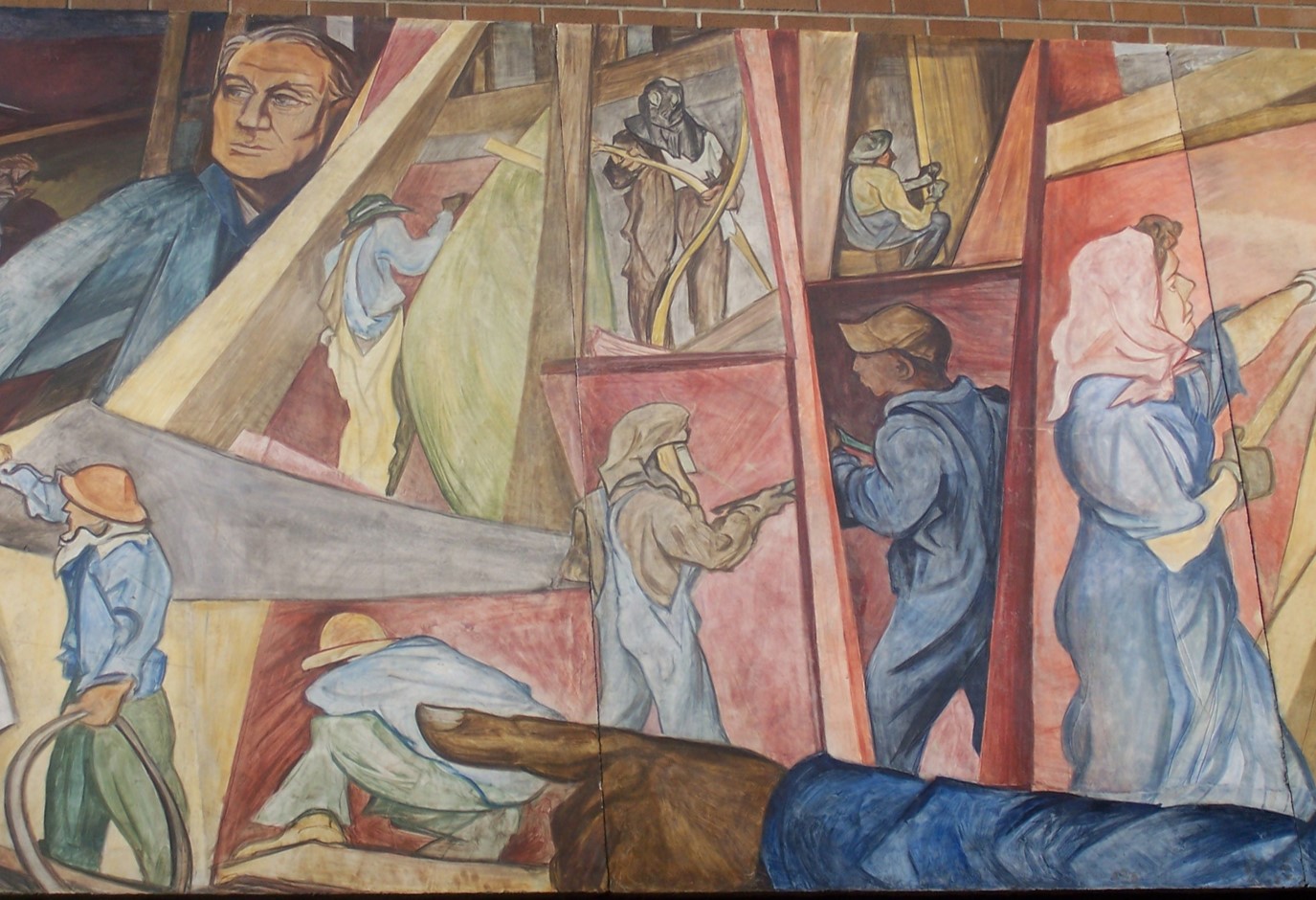 Mural 3: Ship Scalers at work. Photo: G. M. Peterson
Mural 3: Ship Scalers at work. Photo: G. M. Peterson
To the right of FDR are Ship Scalers on the job, an interethnic workforce that includes women, apropo for the era.
 Mural 4: Worker trio & support for war. Photo: G. M. Peterson
Mural 4: Worker trio & support for war. Photo: G. M. Peterson
In the foreground, linking the lefthand and central sections, is a large trio of workers. Of indeterminate but clearly non-white ethnicity, they represent contributions of peoples of color to important struggles. The lead figure’s arms link the lefthand and central sections of the mural as he points to the FEPC document and hands arms to soldiers in the background, linking the Ship Scalers to the victory over fascism and to the small central panel that once presided over the union hall doorway.
 Mural 5: Handclasp. Photo: G. M. Peterson
Mural 5: Handclasp. Photo: G. M. Peterson
The center panel pictures two hands of different hues, clasped and linking the prewar and postwar worlds depicted to the left and right.
 Mural 6: Smashing a swastika/postwar world. Photo: G. M. Peterson
Mural 6: Smashing a swastika/postwar world. Photo: G. M. Peterson
The righthand side of the mural moves from challenges of the Post-World War Two world to visions of “the left.” First, a blue-shirted man in a hard hat or helmet smashes a swastika with his formidable fist.
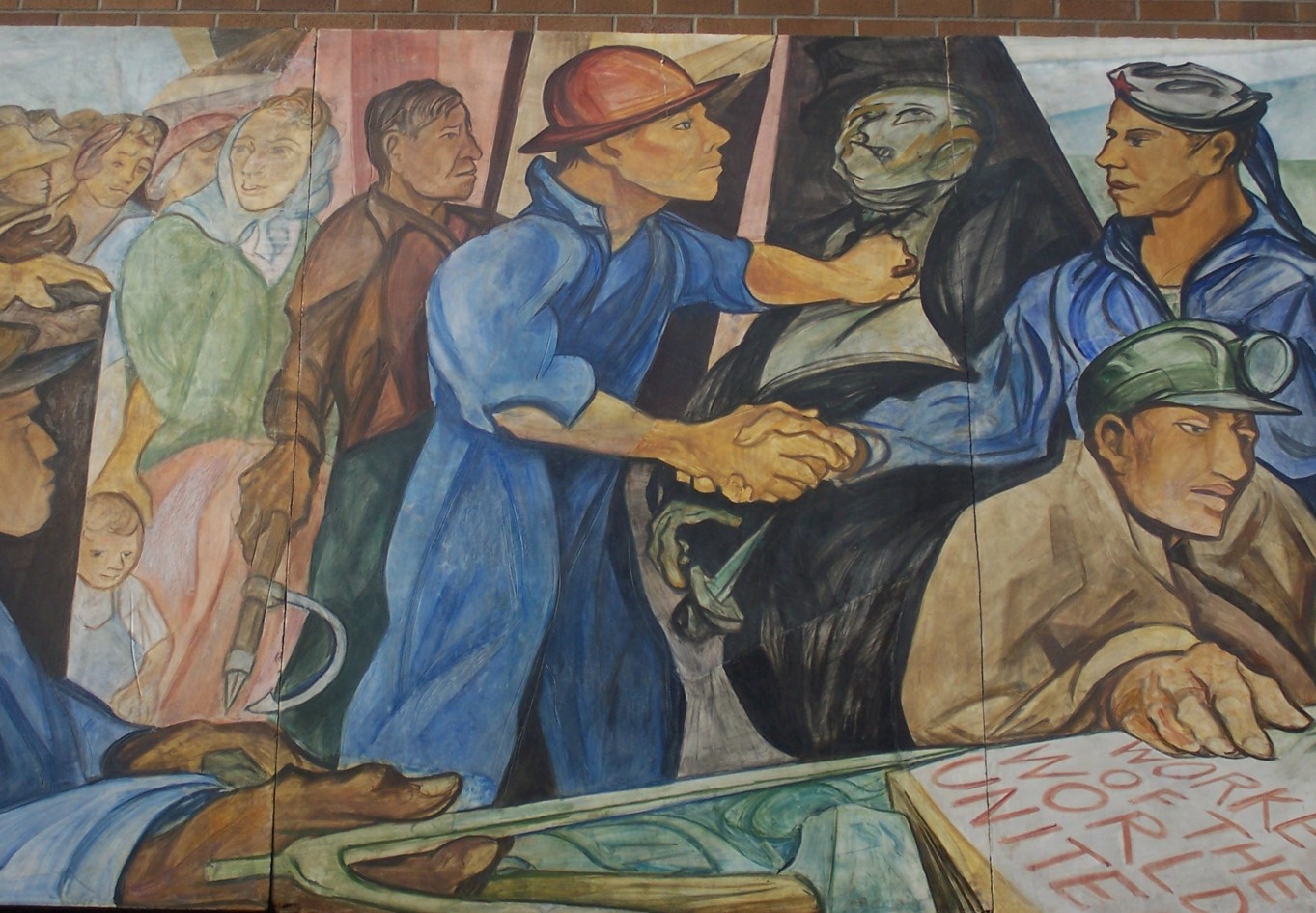 Mural 7: Worker and Soviet sailor. Photo: G. M. Peterson
Mural 7: Worker and Soviet sailor. Photo: G. M. Peterson
To his right are refugees and, in the foreground, a similarly-attired man shaking hands with a Soviet sailor and pushing a cadaverous-looking capitalist into what looks like a coffin.
 Mural 8: Build a free world! Unite! Photo: G. M. Peterson
Mural 8: Build a free world! Unite! Photo: G. M. Peterson
In the foreground and center of the righthand panel Ship Scalers general secretary Del Castle (sporting a hammer and sickle) and other SSU members unscroll an internationalist message: “Build a free world - No Masters - No Slaves - Workers of the World, Unite!” Behind Castle is another figure, and then a likeness of Mexican labor leader Vicente Lombardo Toledano, by then a target of the US State Department. The last figures on the right are more workers – possible of Asian or Latin American origin – breaking chains of oppression.
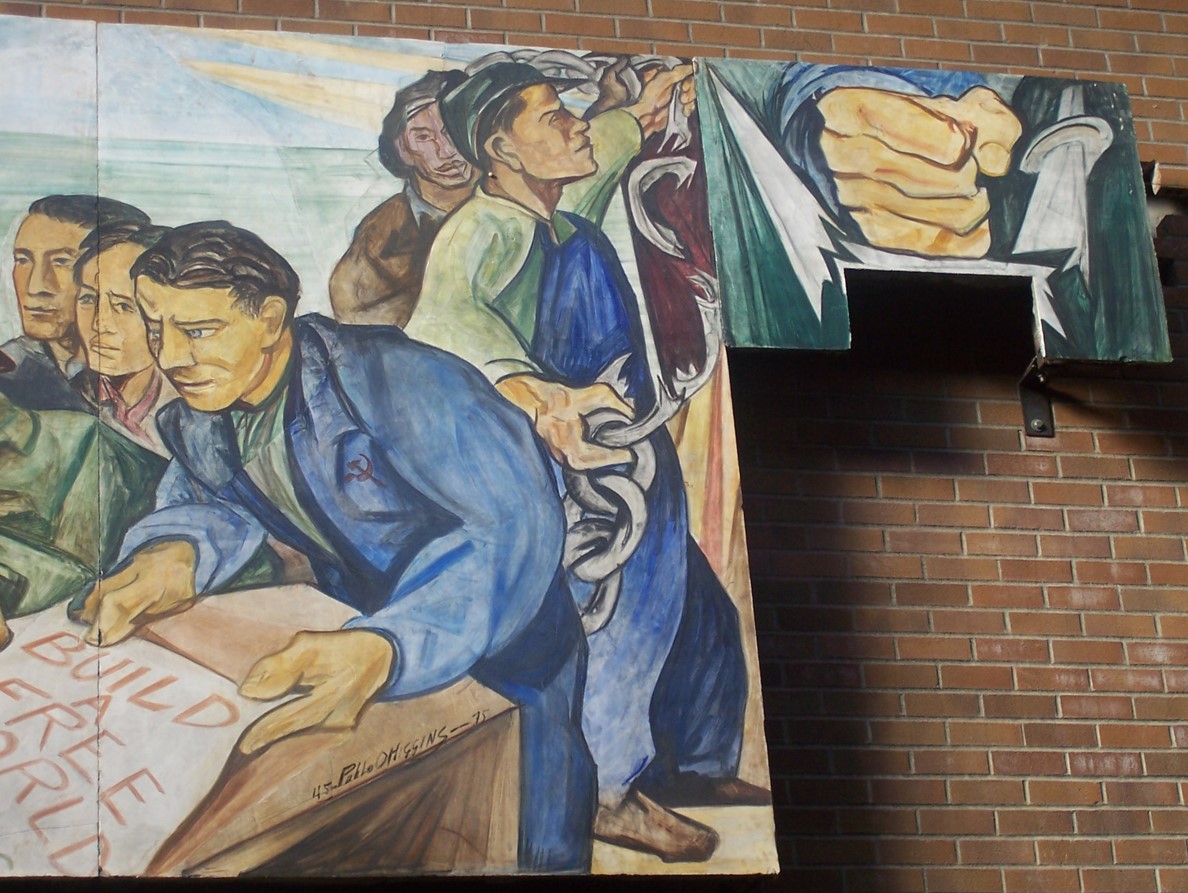 Mural 9: Smashing a sword. Photo: G. M. Peterson
Mural 9: Smashing a sword. Photo: G. M. Peterson
The final panel pictures a fist smashing a sword, symbolizing workers’ part in creating a peaceful postwar world.
American-Mexican Artist
The creation of the Ship Scalers mural owes to a unique period in the history of inter-American relations. Beginning in the 1920s and continuing into the 1940s, Mexico’s artistic and political currents served as inspiration to many, in the USA and beyond. The military stage of the Mexican Revolution, 1910-1920, had passed, and the Mexican state – and central party – continued to engage in its own consolidation and in various reforms. It supported educational and public arts projects to promote a new national identity that celebrated “_la Raza cósmica_” (the “cosmic race”) and a history of struggle for social change. By the mid-1930s, a militant labor-left conducted international outreach, and labor and civil rights activists in the US reciprocated. People, ideas, and information circulated between Mexico and the USA. One friend of O’Higgins who promoted Mexican-US labor and leftwing collaboration in the era was Mexican labor leader, Vicente Lombardo Toledano.
A leftist who headed the CTM (Confederation of Mexican Workers)—an equivalent and ally of the CIO (Congress of Industrial Organizations)—Lombardo challenged US imperialism and discrimination. His work included efforts to use the organizing meetings of the United Nations to address discrimination; the fact that O’Higgins dedicated the mural “to the Peoples of the United Nations” indicates a similar hope.3
O’Higgins played an important role in Mexican-US connections. Born Paul Higgins in Salt Lake City, Utah, in 1904, he lived the transnational identity characterizing the U.S.-Mexican borderlands and by 1961 was a Mexican citizen as well as a renowned “Mexican artist.” Of Scots-Irish heritage, he grew up in Utah and California, where he learned colloquial Spanish and by the 1920s became fascinated with revolutionary Mexico. In 1924, he set off for Mexico City with a letter of invitation from Diego Rivera. Initially assisting and learning from this master muralist, he plunged into artistic and leftist political circles in Mexico and beyond. He joined the Mexican Communist Party (PCM) in 1927 and studied art on scholarship in the Soviet Union in 1930-31. O’Higgins returned frequently to the US for his own exhibits and projects, which in 1931 included illustrations contributed to the CPUSA’s The Daily Worker.4
In Mexico, he worked with the anti-fascist League of Revolutionary Artists and Writers (Liga de Escritores y Artistas Revolucionarias, or LEAR) and in 1937 helped found the Taller de Gráfica Popular, an artist collective which produced flyers, posters, and illustrations to fight fascism, racism, and the exploitation of working peoples. His artwork included politically-themed posters and flyers, and just before the commissioning of the Ship Scalers mural he was engaged in such activity in the San Francisco area, producing, for example, a poster for the wartime Office of the Coordinator of Inter-American Affairs.5
Recognized for his non-political art as well, O’Higgins continued to exhibit his work in both Mexico and the United States—including in the “Twenty Centuries of Mexican Art” exhibit curated by the Museum of Modern Art in 1940.6 He was also known for his generosity in supporting other artists, including teaching them mural and fresco techniques. Some of these individuals brought their learning back to the US, applying it to public murals for the Works Progress Administration (WPA), and in the case of UW art professors Ambrose and Viola Pattterson, to a fresco at their home.7
So far, no documentation in Ship Scalers Union records discusses the contracting of the mural, but other sources point to local CPUSA activist Hallie Donaldson as a key connection. O’Higgins was working in San Francisco in 1944, teaching art in the California Labor School and producing flyers and leaflets. An artist and teacher in Seattle, Donaldson had worked with O’Higgins in the Taller de Gráfica Popular and was a friend of Ship Scalers general secretary Del Castle.8 Donaldson and O’Higgins exemplify the transnational connections that shaped leftist-labor activism of the era, and one sees this among the Ship Scalers as well. Though union records for the 1940s are incomplete, SSU papers contain evidence of the union’s diverse membership and its support for various international and civil rights causes.9
In 1959, Ship Scalers Local 541 faced financial difficulties and voted to sell their deteriorating union hall. Fred Berry was charged with donating the mural to the Seattle Art Museum.10 It ended up at the University of Washington instead.
Sources indicate that two architecture professors took the fresco—cut into separate panels—on behalf of the University of Washington.11 It appears that the UW Physical Plant crated the pieces and somehow the hoped-for redisplay never happened. Union meeting minutes from July 1959 record a “Letter from the University of Washington, thanking the union for the donation of the mural. M/S to file… Carried.”12 So far, this letter has not been located in current SSU archives, nor in UW records from 1970s when investigations of this donation began. In the mid-1970s, all parties claimed that the crated fresco had been stored and forgotten for some twenty years.
They were apparently unaware that in 1967, a Mrs. Hossom wrote from Eastern Washington to inquire about the mural and learned that “for a very large fee” the UW Physical Plant could uncrate it for her viewing. Instead she settled for a photo of the mural sent to her by one of the union officers.13
Mural recovery movement
The mural’s recovery in 1975 was due to an attorney, a new generation of activists, and the artist. The bridge across generations was Seattle’s longtime labor and civil rights attorney John Caughlan (who represented the Ship Scalers). Reflecting decades of demographic change in Washington, Mexican American activists formed the core of a mural restoration movement, aided by Caughlan.
In late 1974, Caughlan recalled seeing the creation of the mural and began inquiring about it at the UW. He informed Roberto Maestas, then a UW adjunct professor and co-founder of El Centro de la Raza, a Latino community center, about the artwork. Maestas mobilized some of his students to take up the cause, and they soon involved the campus chapter of MEChA (Movimiento Estudiantil Chicano de Aztlán) and El Centro in a mural recovery effort.
Caughlan assisted the group in drawing up their demands, and tracked down and corresponded with O’Higgins in Mexico City.14 He speculated that the mural moved from the union hall in 1955, and this recollection seems to have shaped the date published in many sources over the years and appearing on the initial plaque.
If memory did not exactly pinpoint when the mural left the union hall, historical memory did contextualize the fresco’s production and ongoing resonance for the community. Activists emphasized the work’s ties to the Mexican Revolution and its importance in a long history of struggles for rights.15
The mural recovery movement occurred in the context of a new “struggle against discrimination” and calls for change at the university. Building on earlier student organizations, the UW MEChA chapter was active by 1969 and flourishing in the early 1970s, collaborating with community organizations like El Centro de la Raza and engaging in a variety of actions. As on many other campuses, the UW saw protests and critical media coverage about allegations of discrimination in curriculum, hiring, and treatment of staff.16
By May 1975, these concerns led some twenty-one Chicana/o faculty and staff to threaten a mass resignation. Their letter to UW President John Hogness quoted Emiliano Zapata, a hero of the Mexican Revolution.17 Local papers also publicized the mural recovery movement, including the accusation that the university had been “hiding” the fresco. Activists demanded that it be found, restored by the artist, and returned, with apologies, to “the people.”18
In comparison to many other calls for change on campus, these demands seem to have been easier to meet. On May 18, the Campus Art Collection Committee voted to restore the mural and give it to El Centro “on indefinite loan.” They voted to act swiftly to meet funding application deadlines for the $5,000 to $10,000 needed for restoration. The UW Board of Regents would simply “be informed of the committee vote.”19 The University created a new Minority Scholars fellowship, with Scots-Irish-American-turned-Mexican Pablo O’Higgins to be the first recipient.
In September, O’Higgins arrived in Seattle to restore the mural. He also offered a fresco class and brought works for a well-received exhibit of his art.20
An “elegant” campus reception soured when Gallo champagne was served. University organizers were apparently unaware that, “At that moment in history Gallo was the most hated expression in Chicano/Mexicano country because of the boycott of Gallo products.”21 If only they had paid attention to their campus MEChAchapter about the struggles of farmworkers.
Ownership controversy
The issue of who owns the mural remains complicated. In February 1975, Ship Scalers official Van Harrison wrote a letter asserting that “Since this is a work by a Chicano depicting the history of the Ship Scalers Union I would recommend that the mural…be returned to the working class…[and] be placed at the location of El Centro.”22 There is no record of a union vote on the matter, as had happened with its donation of the mural to the UW in 1959. El Centro was unable to raise funds to mount the heavy fresco, and in 1977 it moved from the basement of Kane Hall to its current location. Harrison’s use of the term “Chicano” reflects how some recovery activists framed the mural at the time, rather than a clear understanding of the artist’s background.
No one seemed to have uncovered the 1959 UW letter of thanks referred to in SSU meeting minutes. The archives reveal that Ship Scalers’ understandings of the mural history also demonstrated lapses, as did various writings about the mural. After the SSU local had been dissolved by its international, a 1986 agenda for “winding up the affairs of the union” contained a motion “That the mural “The Struggle Against Racial Discrimination” by Pablo O’Higgins be officially donated to the University of Washington, with a request that a plaque be displayed with the mural, crediting the Ship Scalers Union with the creation of the mural, and briefly explaining its history.” At the time it was worded in the mid-1970s, the initial plaque placed beside the fresco was described as “a compromise.” The updated plaque better explains the mural’s tumultuous journey and its significance.
The Ship Scalers Mural is a treasure from a unique era of collaboration between Mexican and US labor activists, leftists, and artists—categories that often overlapped, as in the case of Pablo O’Higgins. He and the union that commissioned him shared the “struggle against racial discrimination,” and transnational perspectives. A generation later, Mexican influences again shaped Seattle as a new generation of activists battled discrimination, not on the waterfront but in academia. Thanks to their efforts, the mural now hangs in a busy University of Washington building and across from one of the swanky event and meeting rooms on campus. Thanks to continuing donations to archives, the story of the mural will never be finished.
copyright © Gigi A. Peterson 2018
Professor Peterson researches the history of activism for labor, civil, and immigrant rights and teaches at the State University of New York at Cortland. She is the author of a more detailed article on the mural’s history, “Recobrando/Recovering ‘The Struggle Against Racial Discrimination’: The Journey of Pablo O’Higgins’s Mural for the Ship Scalers Union of Seattle.” L_abor: Studies in Working Class History of the Americas (_Winter 2012) 7-40. She notes some needed corrections to the historical record (including this article) after finding evidence that the mural moved from its original location in 1959, and not 1955.
The following video explores the mural and Professor Peterson’s discussion of its evolving history, and also features UW Professor Erasmo Gamboa, who participated in the movement for the fresco’s recovery in 1975: UWTV, Labor Archives: Progressive Art
1 Accepting an invitation to become an honorary member of the New York Workingmen’s Democratic Republican Association, Lincoln bemoaned “The hanging of some working people by other working people” [in New York City] and noted “It should never be so. The strongest bond of human sympathy, outside of the family relation, should be one uniting all working people, of all nations, and tongues, and kindreds.” His next line did not make it into the Ship Scalers mural, “Nor should this lead to a war upon property, or the owners of property.” Abraham Lincoln, “Reply to New York Workingmen’s Democratic Republican Association,” March 21, 1864.
2 FBI SAC [special agent in charge], “Report on John Caughlan: Fair Employment Practice Commission,” 25 April 1946, box 1, file 1, “FBI File: Part I,” Accession 704 John Caughlan Papers (hereafter JC Papers).
3 To learn more about the Mexican and US union ties, see Gigi Peterson, “‘A Dangerous Demagogue’: Containing the Influence of the Mexican Labor-Left and Its U.S. Allies,” in American Labor and the Cold War, ed. Robert Cherny, William Issel, and Kieran Walsh Taylor (New Brunswick, NJ: Rutgers University Press, 2004), 245 – 76, and “Grassroots Good Neighbors: Connections between Mexican and US Labor and Civil Rights Activists, 1936 – 45” (PhD diss., University of Washington, 1998).
4 Useful sources include: Elena Poniatowska and Gilberto Bosques, Pablo O’Higgins (Mexico City: Fondo Editoríal de Plástica Mexicana, 1984); Letícia López Orozco, ed., Pablo O’Higgins: Voz de lucha y de arte (Mexico City: Fundación Cultural María y Pablo O’Higgins, 2005); Susan Vogel, Becoming Pablo O’Higgins: How an Anglo-American Artists from Utha Became a Mexican Muralist (San Francisco: Pince Nez Press, 2010); Leonard Folgerait, “O’Higgins y el Daily Worker,” Voz de lucha, pp. 69-77; and Deborah Caplow, Leopoldo Mendez: Revolutionary Art and the Mexican Print (Univ. of Texas Press, 2007).
5 Vogel, Becoming Pablo O’Higgins, 144-49. Designed for the New York office of the Coordinator of Inter-American Affairs, Good Neighbors, Good Friends featured large portraits of Lincoln and Juárez (contemporaries who admired each other), and a Mexican and a US worker, similarly attired, shaking hands in the background.
6 Inter-American Development Bank Cultural Center, “Artful Diplomacy: Art as Latin America’s Ambassador in Washington, DC,” IADB Cultural Center, Information Bulletin no. 97 www.iadb.org/exr/cultural/information_bulletins/bi97_eng.pdf (accessed August 5, 2009).
7 “Art on a Mexican Wall,” Time, April 1, 1935; “The Mexican Murals of Marion and Grace Greenwood,” in Out of Context: American Artists Abroad, ed. Laura Rachel Felleman Fattal and Carol Salus (Santa Barbara, CA: Praeger, 2004), 115 – 24. Rebecca Mina Schreiber, Cold War Exiles in Mexico: U.S. Dissidents and the Culture of Critical Resistance (Minneapolis: University of Minnesota Press, 2008) 52 –53. Robert Rightmire’s research continues to bring the work of Ryah Ludins into the historical record, as seen in Katie Hall, “Ludins Exhibit a Tribute to Forgotten Artist,” The Cortland Standard, July 3, 2010. Rightmire found that Ludins had “mixed paints and done some preliminary work” for O’Higgins; email to the author, July 29, 2010. Ambrose and Viola Patterson, faculty members at the University of Washington visited Mexico in 1934 O’Higgins gave them artistic and travel advice, taught them fresco techniques, and let them work on one of his murals. They even applied fresco techniques they learned from him to painting a fresco of “The Taxco Market” at their Laurelhurst home. See Collection 2563-2: Ambrose and Viola Patterson, University of Washington Special Collections, including Viola Patterson, interview by William Hoppe, Seattle, WA, July 10, 1972, 21 – 23.
8 Records indicate that O’Higgins taught art classes at the California Labor School and that he used his artistic talents in other ways to promote the Allied cause. John Caughlan is quoted in Vogel, 283, 3 (1991 interview by Susan Vogel) This interview confirms an unsourced statement that Donaldson suggested O’Higgins to Ship Scalers President Del Castle; Lauro Flores, “Pablo O’Higgins: Pintura y Sociedad” in Metamorfasis: The Journal of Northwest Chicano Magazine of Art and Culture 4, no. 2, and 5, no. 1 (1982⁄1983), 27. Caughlan’s widow Goldie also recalled a woman CP activist who was involved in suggesting O’Higgins for the mural; Goldie Caughlan, interview by the author, February 10, 2007. A Mexican source states that Castle contracted O’Higgins, but misspells his name as “Castell” and offers no citations; Eduardo Espeinos Campos, Pablo O’Higgins: Cronología de su obra gráfica, Discurso Visual: Revista Digital — enero-abril 2007 CENIDIAP (Consejo Nacional para la Cultura y las Artes), http://discursovisual.cenart.gob.mx/dvwebne08/documentos/doceduardo.htm
9 In the summer of 1944 for example, the Local combatted discrimination against African-American women at the Winslow Marine Shipyard; Box 7, folder 8 “Individual Statements and Letters to the Executive Board from workers Combatting Discrimination at the Winslow Marine Railway and Shipbuilding Co., 1944,” Ship Scalers Dry Dock and Boat Yard Workers Union, Local 541 Records, (hereafter SSU) Accession 4571-002, UW Libraries, Special Collections.
10 Ship Scalers Union, Minutes of “Regular Meeting,” 14 February 1959, Box 1, folder 33 “January-June 1959,” SSU Records.
11 These were professors Victor Steinbrueck and Robert Dietz. Sources on Steinbrueck’s role include Goldie Caughlan, interview by the author, February 10, 2007; John Caughlan to Victor Steinbrueck, December 18, 1981, box 23, folder 22-23, Pablo O’Higgins, JC Papers; and Lauro Flores, “Pablo O’Higgins,” Metamorfosis. In 1981, John Caughlan asked Steinbrueck to assist with preserving the O’Higgins ILWU mural in Honolulu, “partly because [Steinbrueck] was instrumental in saving the Shipscaler murals back in the 50’s”; John Caughlan to Victor Steinbrueck, 18 December, 1981, Seattle, WA, box 23, “Pablo O’Higgins” folder, JC Papers.
12 Seattle Ship Scalers Union, Meeting minutes 11 July 1959. Box 1, folder 34: July-Dec. 1959, SSU records.
13 A 2012 donation of SSU records included 1967 correspondence between SSU Business Agent Donald Cameron and Mrs. H.K. Hossom, who had a background in Mexican art and succeeded in finding a UW Physical Plant contact who had located the fresco panels but wanted “a very large fee” to “open the crates.” Instead, Cameron sent her the union’s only photo of the mural, which I have not been able to locate in the current SSU collection; seeitems in Box 4, folder 58 “General Correspondence, 1939-1982, SSU Records.
14 Goldie Caughlan, interview by Gigi Peterson, February 10, 2007 and items in Box 1, folder 1 “Correspondence: Mexican Muralist Pablo O’Higgins and John Caughlan, 1975-1981,” SSU Records.
15 Statement: Wednesday, 5 March 1975, box 7, folder 17: “Pablo O’Higgins Mural,” Tomás Ybarra-Frausto Papers (hereafter TYF Papers), Accession 4339, UW Libraries Special Collections.
16 University of Washington Libraries Special Collections contain many documents with, or responding to, critiques of discriminatory practices at the UW. Useful collections include the TYF Papers noted above and the Teresa Aragon Shepro Papers (hereafter TAS Papers), Accession 2913-002 and W.U. Vice President of Student Affairs [hereafter VPSA], Accession 86-014. Examples of documents include “The Obstacles to Tranquility at the U. of W.,” 12 May 1975, box 1, folder 13, VPSA . For UW MEChA history, see Oscar Rosales Casteñeda, “Timeline: Movimiento from 1960 –1985,” SCRLHP, mecha_timeline.htm (accessed June 19, 2008) One helpful source for El Centro is Bruce Johansen, “Mestizo Nation: La Plaza de Seattle,” in Legal, Cultural, and Environmental Revival, vol. 2 of The Praeger Handbook on Contemporary Issues in Native America (Westport, CT: Praeger, 2007), 229 – 44.
17 Gregorio Ochoa, Theresa de Shepro, Roberto Garfias, Tomas Ybarra-Frausto, Yvonne Yarbro, Carlos Gil, Ruben Sierra, Luis Torres, Jeanne Lopez-Valadez, John Valadez, and Lawrence Mosqueda to John Hogness, 6 May 1975, box 1, folder 13, TAS Papers.
18 Statement: Wednesday, 5 March 1975, TYF Papers; Hilda Bryant, “Major Artwork ‘Found’ at UW,” Seattle Post-Intelligencer, March 6, 1975. The article continued on another page with the headline “Chicano Mural ‘Found’ at UW.”
19 “Chicano Center May Get U.W. Fresco,” Seattle Times, May 18, 1975.
20, Fred Cordova (UW Information Services), “Pablo O’Higgins,” press release, 6 October 1975, box 25, Pablo O’Higgins folder Henry Art Gallery Papers, (hereafter HAG); Fred Cordova, “Unveiling of Pablo O’Higgins Mural,” press release, 23 October 1975, box 9, unlabeled envelope, and Deloris Tarzan, “Mexican Muralist Honored at U.W.,” Seattle Times, October 24, 1975, box 9, unlabeled envelope, HAG Records
21 Roberto Maestas, e-mail to Gigi Peterson, January 30, 2007. The incident is also documented in UW records, including an unsigned note from Maestas to Tomás, n.d., box 6, folder 5, TYF Papers. Vogel recounts the same story from her 2009 interview with Maestas; Vogel, Becoming Pablo O’Higgins, 229-30.
22 Van. T. Harrison, “To Whom It May Concern,” 2 February 1975, box 7, folder 17 (“Pablo O’Higgins Mural”), TYF Papers.
